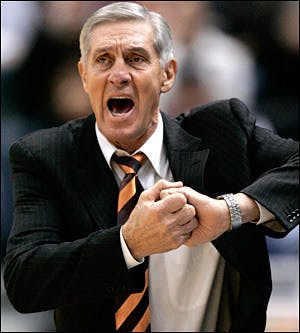An employee of 23 years quits suddenly. What do you do?
That’s the question the NBA’s Utah Jazz were faced with when their coach of 23 years, Jerry Sloan, decided to resign suddenly during mid-season yesterday:
I had a feeling this time was the time to move on,” an emotional Sloan said during a Thursday afternoon news conference. “[That’s] a long time to be in one organization. Again, I’ve been blessed. Today is a new day. When I get this over with, I’ll feel better. My time is up and it’s time to move on.”
Longtime assistant Phil Johnson also resigned, surprising even Sloan during their post-game chat Wednesday night with general manager Kevin O’Connor.
“I came with him and I’ll leave with him,” the 69-year-old Johnson said Thursday.
So, what would you do if you were in charge of the Jazz organization?
Longevity in a profession with little of it
Coaching is a profession with high turnover. In Sloan’s case, it’s extreme.
For example, he was promoted to head coach in 1988. The next longest tenured head coach (Gregg Popovich of the San Antonio Spurs) was hired in 1996. The next in line (Doc Rivers of the Boston Celtics) was hired in 2004. A large majority of teams have had their coaches for less than five years. That makes Sloan’s 23 years at the helm even more remarkable.
The organization was stable with him leading the charge for so long. In an environment where coaches are often seen as disposable and could be changed at the behest of a star player, Utah was often the lone exception to that rule. He became an institution in Salt Lake City.
All changed in a moment
Coaching changes are becoming more common in mid-season, but coaching changes initiated by the coach himself? It’s unheard of — especially with Sloan’s longevity in the position.
There has been speculation that an on-court dispute finally pushed him over the edge and into resigning. ESPN reported that Sloan had an argument with Deron Williams, a key player for the team. Even if it ends up not being the complete story, the timing itself would be an odd coincidence.
Suffice to say, it wouldn’t be the first time a high performing star employee drove a manager out of a job. Star employees can demand much from other staff (including their managers) and it can be a difficult dynamic to handle as a manager. However, Sloan has dealt with top talent before and handled it well (the last time he had not one, but two top stars, he went to the NBA Finals two years in a row).
Will longevity count?
The Utah Jazz have tapped current assistant coach Tyrone Corbin to coach the team forward. What was unusual about this move is that teams usually place an interim tag on a new head coach, even if they intend to hire him after the season ends. Utah has been clear that it intends to keep Corbin past the end of this season.
It will be interesting how the Jazz recover from this sudden turnover of its most visible management position. As I said earlier this week in a post about longevity:
I can’t imagine the actual dollar value of having a high-performing employee who knows the history, struggles, and successes of the organization so well. At a certain point, institutional knowledge becomes so second-nature that a person becomes nearly irreplaceable.
And:
The last thing worth mentioning is if you have a great culture, longevity helps protect that culture from shifting. CEO’s and top execs who stay at a company for long periods of time have proven that year over year.
Good luck to Jerry Sloan moving on, but maybe that luck should be reserved for the Jazz, who have to try to move on from the loss of a legendary figure in their organization. Even as a Portland Trail Blazer fan who rarely finds a reason to celebrate anything related to the Utah Jazz, I tip my hat to the legacy and example Sloan has given every coach.
